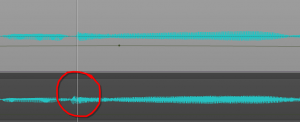by Jimmy Landry
 Things have obviously changed in music production over the years, but just recently a few technological advances have surfaced that are game-changers. One of these items includes the VocalSync technology inside the new SONAR Platinum. What exactly is VocalSync and why should you care? Here is one real-world practical example:
Things have obviously changed in music production over the years, but just recently a few technological advances have surfaced that are game-changers. One of these items includes the VocalSync technology inside the new SONAR Platinum. What exactly is VocalSync and why should you care? Here is one real-world practical example:
VocalSync is a tool that’s integrated directly inside of SONAR Platinum which gives anyone working with vocals 2 distinct benefits:
1. The ability to save a lot of time from manual editing
2. The sonic advantage of producing tight professional sounding multi-tracked vocals
It does this by “guiding” or conforming the information on one track to match another more fluently. The outcome of this is a much more professional production sound in the vocal tracks.
 Let’s take a look at a real-world example: Recently, I had the good fortune to work with a great artist from Finland by the name of Peppina who has made a name for herself through Joseph
Let’s take a look at a real-world example: Recently, I had the good fortune to work with a great artist from Finland by the name of Peppina who has made a name for herself through Joseph Gordon-Levitt’s brainchild platform HitRecord. If I had to compare or categorize her music I would say it’s a modernized version of Dido sprinkled with some Sarah Bareilles and Ingrid Michaelson. With my producer hat on, I thought to myself that her vocals needed to be very large and wide on the tracks, but they also needed to sound authentic, realistic and intimate. To achieve this sound for the lead vocal, I used VocalSync to tighten 3 “takes” that would work together strategically in the stereo field.
Gordon-Levitt’s brainchild platform HitRecord. If I had to compare or categorize her music I would say it’s a modernized version of Dido sprinkled with some Sarah Bareilles and Ingrid Michaelson. With my producer hat on, I thought to myself that her vocals needed to be very large and wide on the tracks, but they also needed to sound authentic, realistic and intimate. To achieve this sound for the lead vocal, I used VocalSync to tighten 3 “takes” that would work together strategically in the stereo field.
First, using SONAR’s comping tool, I was able to get my main lead vocal together quickly. I took about 5 performances [keepers] going from each song part. Once I was done, I went back and quickly comped two more tracks which would serve as my support system to the lead vocal. Now usually after getting a lead track, I would either have the singer back in to painstakingly try to match the lead vocal, or I would meticulously go through the supporting tracks and slice up – and move the trouble spots. These trouble spots are usually at the beginning and ending of words and include any “cutting” constants such as “T” “P” “K” etc. (Image below shows pre-VocalSync with vocals not lining up.)
Here is where the time-saving function of VocalSync came into play. After comping the 2 supporting tracks, I simply went through each part of the song using VocalSync, pointing them to the “Comp Vocal” track and then rendering them. VocalSync’s knob allowed me to dial-in the precise amount of tightening needed so that all the vocals worked well together. Since I was utilizing 3 vocal  takes, this would have taken me hours to get right without VocalSync. In essence, I would have had to go through each vocal take solo’d and listen for inconsistencies while fixing each problem manually. (Image to the left shows post-VocalSync with same vocals tight.)
takes, this would have taken me hours to get right without VocalSync. In essence, I would have had to go through each vocal take solo’d and listen for inconsistencies while fixing each problem manually. (Image to the left shows post-VocalSync with same vocals tight.)
When all was said and done, my vocal approach utilizing VocalSync allowed me to run the lead vocal up the middle, and then run the 2 VocalSynced tracks panned out left and right (about 30%) at a lower fader volume with a different EQ. The result was a much wider vocal sound while keeping an authentic and intimate performance which is what I needed.  To explain further, the effect I needed was not the typical “doubling” effect, but rather a more inconspicuous genuine performance with a wider appearance in the spectrum – this was easily achieved in a very timely manner thanks to VocalSync. If you take a listen to the track example below in headphones you will hear what I mean; and it’s a bit more evident in the chorus of the song.
To explain further, the effect I needed was not the typical “doubling” effect, but rather a more inconspicuous genuine performance with a wider appearance in the spectrum – this was easily achieved in a very timely manner thanks to VocalSync. If you take a listen to the track example below in headphones you will hear what I mean; and it’s a bit more evident in the chorus of the song.
This is just one example on how VocalSync can give you a more professional sound in way less time than traditional editing. Another example which I will get into on my next VocalSync blog was achieving a polished background vocal, and placing that into the mix around these large-and-wide lead vocal tracks. Thanks for reading

